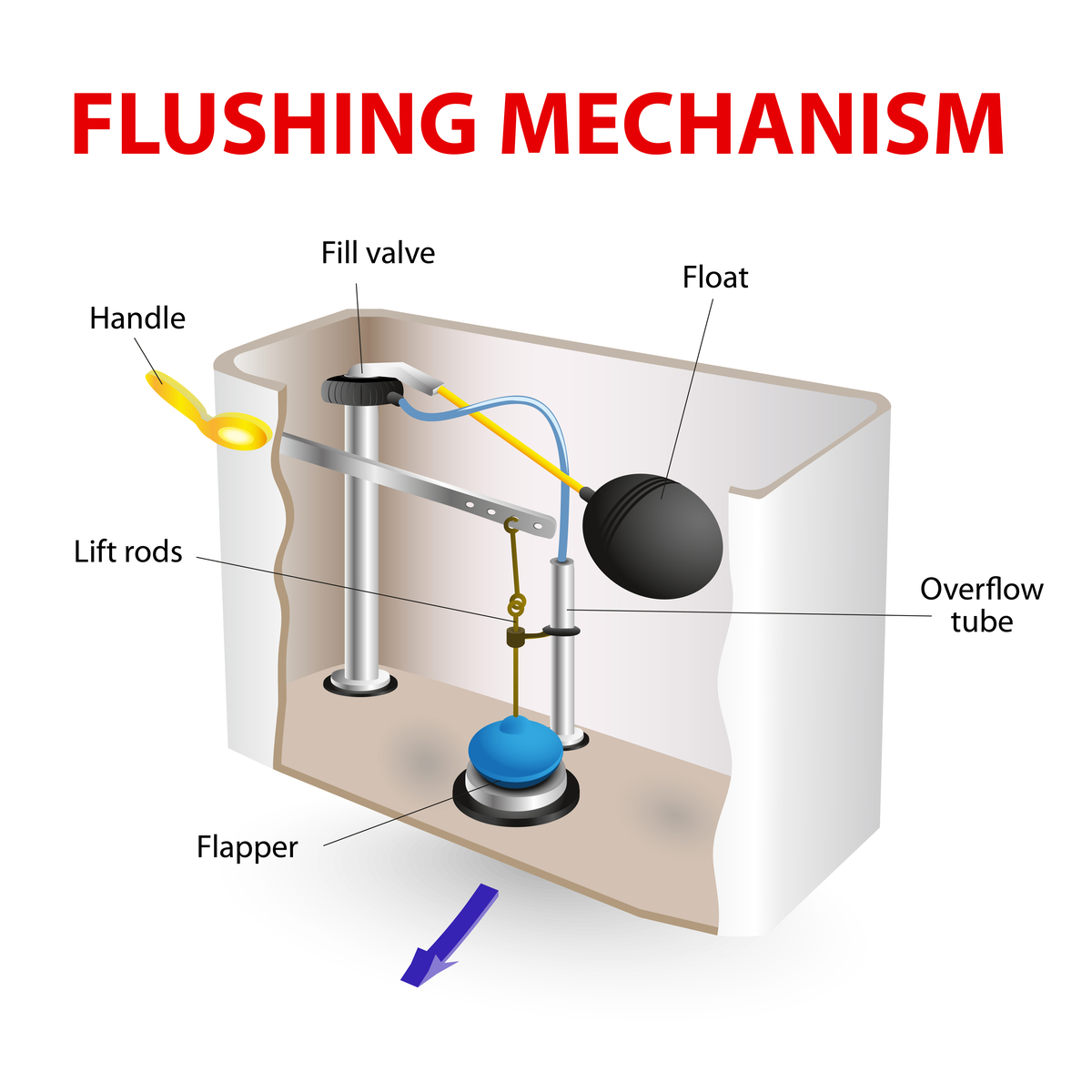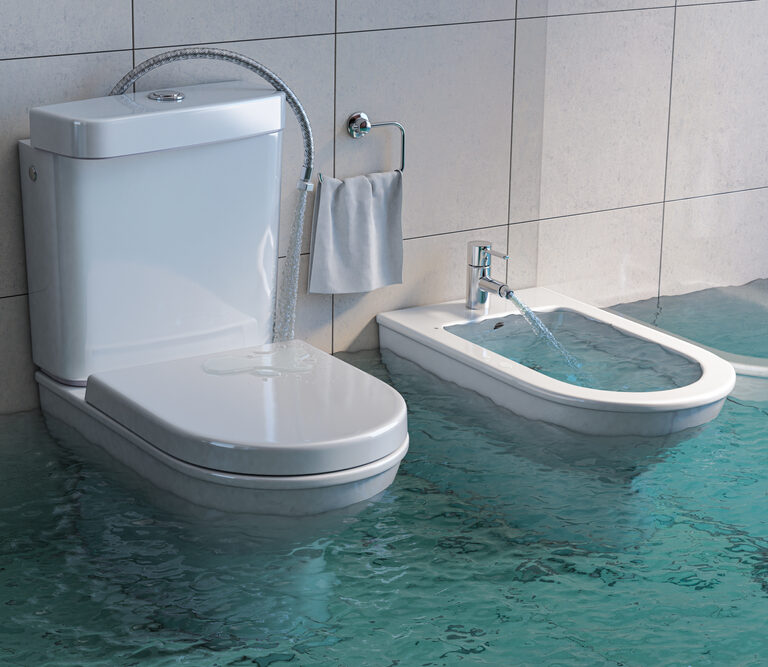Clogged and overflowing toilets are a relatively common problem that just about everyone will have to deal with at least a few times throughout their life. Knowing how to fix an overflowing toilet quickly, and how to prevent it from happening, will help ensure your bathroom remains clean and functional long into the future.
If your toilet is overflowing now, the various options for fixing it are listed next. If you want to learn why it is happening so that you can prevent it in the future, read through the common causes of a toilet overflowing below.
Fixing an Overflowing Toilet
Whenever dealing with a toilet that is overflowing onto the floor, the first step is going to be to shut off the water as quickly as possible. In general, there are two options for completing this task:
- Close Water Valve – Locate the water valve on the pipe going into the back of the toilet and turn it to the right until it is closed.
- Block the Flapper Valve – If you cannot locate the water valve, lift the lid on the back of the toilet and look for the flapper valve (see image) that lets water into the bowl and make sure it is securely closed.

Clearing a Clogged Toilet
Once the water has been stopped, you will need to clear the waste pipes so that the water can drain out normally. There are several options available for completing this step.
Drain Cleaner
For minor clogs in your toilet, you can use a liquid drain cleaner to push the clog down through the toilet. There are many different drain cleaner products on the market to choose from. These products generally work by lubricating the clog to help it flow down the pipe, and by dissolving toilet paper, hair, and other organic materials that may be clogging the toilet. If you have drain cleaner on hand, simply follow the directions on the bottle to see if it will clear the clog that caused your toilet to overflow.
Simple Plunging
In the vast majority of situations, you will be able to clear a clogged toilet by using a simple plunger. If the water level in the toilet bowl is still very high, wait a few minutes to see if it will slowly drain to a more manageable level so that plunging does not splash the water all over. If it is not draining at all, take a large cup and scoop out several inches of water to give you room to work.
When ready, take your plunger and place the end of it over the drain opening at the bottom of the toilet. Once in place, push the plunger down and pull it up (without breaking the seal over the drain) four or five times in a row. When done, pull the plunger out and see if the water begins to drain. If it does not, repeat this process again to try to clear the clog.
There are many types of plungers, but they all work by forming a seal around this opening and pushing the water down through the pipes. In most cases, this water pressure will push whatever is clogging the pipe through to the larger main drainage pipe in your home, restoring normal functionality to your toilet.
Using a Plumbers Snake
If normal plunging and drain cleaner do not work, your next option is to clear the clog by using a plumber’s snake. This is a tool that works well for larger or especially stubborn clogs, especially if they are further down the pipe.
To use this tool simply take the end of the snake and begin feeding it down into the toilet drain as far as it will go. Once it will not easily feed further, begin turning the handle clockwise on the snake to spin it in the drain. Continue to apply pressure on the snake so that it feeds further into the pipe when possible. The spinning will also “grab” whatever is clogging the drain.
After spinning the handle several times, begin spinning it the opposite way and slowly pull the snake out of the drain. To get a better picture of how this is done, watch this quick video.
Be warned, the snake should pull up whatever is clogging your toilet, so make sure to have somewhere to quickly dispose of it safely.
Call a Plumber
If none of these things work, the problem may be further down in your main pipe, or even in your sewage line going to the city waste or septic tank. If this is the case, you will want to bring in a professional to take care of the problem.
Common Causes of a Toilet Overflowing
There are several common causes of an overflowing toilet. In most cases, you will be able to identify the cause of the problem without much trouble. Once you know the cause, you can take the necessary steps to fix it and even prevent the same thing from happening in the future.
Normal Toilet Clogs
Toilets can often get clogged after normal use. All toilets can become clogged, but modern “low flow” toilets are especially susceptible to this because they use less water per flush in order to be more environmentally friendly.
Fortunately, normal clogs can almost always be cleared very easily with simple plunging or snaking. If you find that your toilet gets clogged in this was on a regular basis, you may want to invest in a dual-flush toilet that allows you to use low-flow flushes for liquid waste, and a higher-flow flush for solid waste.
Foreign Objects Causing Clogs
Another common issue with overflowing toilets is a foreign object causing a clog. Any foreign object that cannot pass through the drainage system of the toilet can cause this type of clog. The most common examples of this are toys put in the toilet by children, bathroom items (such as makeup brushes) that accidently fell into the toilet, and more. This could also include things like baby wipes, sanitary napkins, tampons, and other materials that are not meant to be disposed of in the toilet.
When a foreign object causes a clog you will generally need to remove it using the plumber’s snake. The snake allows you to attempt to pull the object up and out of the toilet rather than just pushing it further down into the pipes. Of course, the best way to prevent this type of thing from happening is make sure everyone knows what can, and what cannot, be flushed down a toilet safely.
Malfunctioning Toilet
Just like all mechanical products, the various parts of a toilet will eventually malfunction. The problem will almost always be with one of the parts located in the back tank of the toilet. To investigate, lift the lid off of the back of the toilet and perform a visual scan.
Look to see where the problem is by closely inspecting each part (see the diagram above). If the water is constantly running, the chances are that there is a problem with the flapper valve, lift rods, the handle, or the float. Check to make sure each of these parts appears to be in good condition and is able to move freely. If there is a problem, buy a replacement part and replace the malfunctioning item according to the instructions.
Septic System Backup
If you have a septic system, the problem could be that your system is not draining properly. This causes the water and other waste to build up in the pipes until your toilet can no longer drain at all. While this is going to be a much more difficult problem to fix, which will require the services of an experienced plumber, it is typically easy to diagnose.
If your septic system is completely backed up, none of the pipes in your home will drain properly. To check to see if this is the issue, simply go to a sink or other drain in your home and try to run some water down it. Make sure to run enough water that it would fill up the pipes and begin backing up if the issue were the main septic line.
After you tun the water down another drain you will know whether the issue is with the whole plumbing system, or just the toilet.
Give Your Toilet a Few Test Flushes
Now that you have stopped your toilet from overflowing and addressed the cause of the issue, you will want to test it out to make sure it is not going to happen again. To do this, simply flush your toilet and let it go through the full process of flushing the water down and then filling the back tank up again. Repeat this process two or three times to ensure everything is working as intended.
